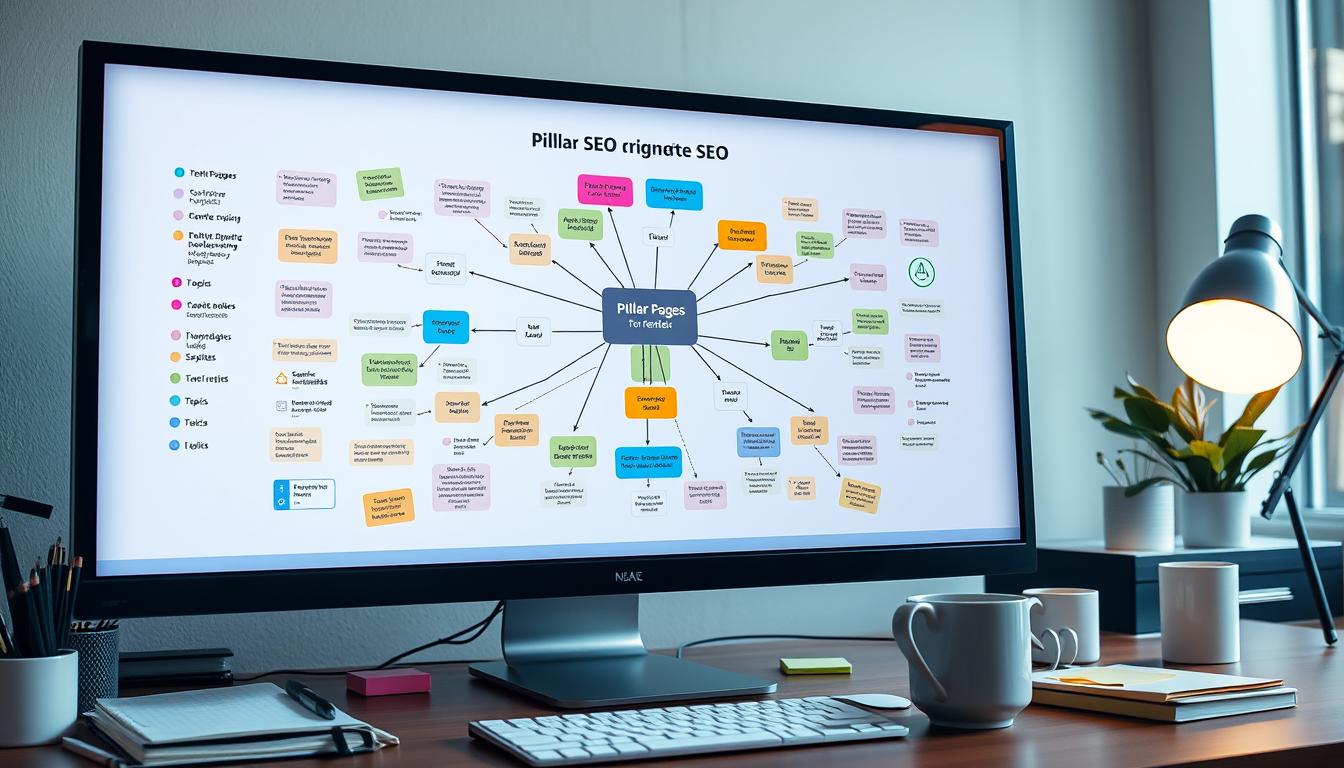Did you know that websites with a well-defined content strategy can see traffic increases of up to 2,000%? The creation of pillar pages for SEO is a pivotal strategy in achieving such remarkable growth. A pillar page functions as a comprehensive guide on a specific topic, linking to related content. This enhances both site navigation and its overall search engine ranking. Understanding the principle behind these pages is essential for anyone aiming to establish a robust SEO pillar content strategy that elevates the user experience.
Constructing effective pillar pages transcends mere keyword stuffing; it involves creating a digital ecosystem where users can effortlessly locate information. By adhering to best practices for pillar pages, you can develop valuable resources that meet user intent and amplify your online presence.
Key Takeaways
- Pillar pages serve as main hubs for related content.
- Effective structure enhances user navigation on your website.
- Integrating SEO best practices improves search engine rankings.
- Identifying relevant topics is crucial for creating pillar pages.
- Quality content fosters user engagement and loyalty.
- Pillar pages are essential for a comprehensive SEO strategy.
What Are Pillar Pages and Why Are They Important?
Pillar pages are pivotal elements within a robust content strategy framework. They function as exhaustive resources, addressing a wide-ranging topic while directing users to more in-depth articles. Grasping the definition of pillar pages is crucial for enhancing your website’s architecture and content sophistication.
Definition of Pillar Pages
The definition of pillar pages refers to a cornerstone content type, aimed at delivering an in-depth overview of a specific subject domain. They form the bedrock of content clusters, effectively integrating disparate articles into a unified framework. This methodology not only streamlines information but also elevates the user’s browsing experience.
The Role of Pillar Pages in SEO
Comprehending the role of pillar pages in SEO can profoundly influence your website’s search engine standing. These pages are instrumental in boosting SEO by establishing a clear navigational path for search engines, facilitating more accurate content indexing. Enhanced user interaction, marked by lower bounce rates, signals to search engines that your content holds value and pertinence.
Benefits of Using Pillar Pages
The benefits of pillar pages are multifaceted and significant. Incorporating pillar pages can yield:
- Enhanced keyword rankings, focusing on broad topics.
- Streamlined site navigation, facilitating easier access to pertinent information.
- Augmented authority in search engine rankings, thereby increasing organic traffic.
These benefits culminate in heightened visibility and credibility for your website, solidifying its reputation as a reliable source within your niche. For a comprehensive guide on integrating these strategies, refer to our terms of use.
How to Identify Topics for Your Pillar Pages
Identifying the right topics for your pillar pages is crucial for effective SEO strategies. Begin by comprehending the needs and preferences of your target audience. The more you understand your audience, the more adept you will be in crafting content that resonates with them. Employing various methods ensures a comprehensive approach to topic selection.
Analyzing Your Target Audience
Understanding your audience is the initial step toward successful pillar content creation for SEO. Effective methods for analyzing your target audience include:
- Conducting surveys to gather direct feedback
- Using analytics tools to track user behavior
- Engaging with your audience on social media platforms
This thorough understanding enables the crafting of topics that genuinely appeal to your potential visitors.
Conducting Keyword Research
Next, conducting keyword research remains a cornerstone of effective content strategies. Utilize tools like Google Keyword Planner or SEMrush to discover popular keywords related to your niche. Focus on long-tail keywords as they often reflect specific user intent. This research will help you identify what your audience searches for most frequently.
Using Competitor Analysis for Topic Ideas
Analyzing competitor content serves as another effective strategy for topic identification. Review the topics they cover and assess their performance. Identify any gaps in their content offering. This can highlight opportunities for your own pillar pages, allowing you to create content that stands out and meets audience needs.
Structuring Your Pillar Page Effectively
The creation of an efficacious pillar page necessitates a meticulous examination of several pivotal elements. Mastery over the structuring of pillar pages is instrumental in augmenting user engagement and optimizing for search engines. The objective is to forge a seamless user experience, fostering continued exploration of your content.
Choosing the Right Format
Diverse formats are suited for disparate content types. Long-form articles or exhaustive guides frequently function as exemplary pillar pages. These formats afford substantial opportunities to impart value and prolong reader engagement. A judicious blend of text, images, and multimedia elements is advisable to craft a comprehensive content experience.
Essential Elements of a Pillar Page
Each pillar page must incorporate critical elements to effectively guide the reader. Structured headers and subheaders are indispensable, delineating the content’s structure. Engaging call-to-action buttons are crucial, prompting further exploration of related subjects. These elements are vital for clarity and navigation enhancement.
Designing a User-Friendly Layout
A user-friendly layout is paramount in retaining visitor interest. Prioritize straightforward navigation and distinct section divisions. Utilizing bulleted lists can significantly improve readability, facilitating rapid information retrieval. A minimalist design not only captures attention but also encourages deeper engagement, rendering it essential for a user-friendly layout.
Creating Quality Content for Your Pillar Page
The quality of content is paramount in the success of your pillar pages. In the realm of SEO, the objective is to develop content that is both substantial and engaging, resonating deeply with your audience. Engaging introductions are crucial, as they draw readers in, establishing the tone for the forthcoming valuable information.
Writing Engaging Introductions
An engaging introduction serves as a gateway, providing context and sparking curiosity. Initiate with a thought-provoking question or an intriguing statement. This strategy motivates readers to delve deeper, promising them a wealth of value. It ensures a compelling start, laying the groundwork for the topic’s exploration.
Incorporating Visuals and Multimedia
Visual elements, such as images, videos, and infographics, significantly enhance the user experience. They serve to break up dense text, making the content more accessible. These multimedia components are vital in optimizing pillar content for search engines, thereby boosting engagement metrics. Include multimedia that complements your text, reinforcing your arguments and enhancing the reader’s comprehension.
Ensuring Comprehensive Coverage
Addressing multiple facets of the topic ensures a well-rounded pillar page. Incorporate detailed insights, examples, and relevant data. This strategy not only elevates content quality but also aids in optimizing pillar content for search engines by offering a more comprehensive resource. Comprehensive coverage guarantees that your audience’s queries are answered, solidifying your page’s reputation as a trusted authority on the subject.
Linking Strategies for Pillar Pages
Effective linking strategies are pivotal in boosting the efficacy of pillar pages. By integrating both internal and external links, a website’s visibility and authority in search engine rankings are significantly enhanced. Mastery over these linking methodologies is crucial for optimizing user experience and the site’s overall structure.
Internal Linking to Support SEO
Internal linking is indispensable for SEO support, guiding users through pertinent content on your site. Strategically embedding internal links within pillar pages facilitates visitor navigation to supplementary resources, thereby diminishing bounce rates. A meticulously organized internal linking framework fortifies the site’s architecture, facilitating search engines’ ability to efficiently crawl and index your pages.
Outbound Linking for Enhanced Authority
Outbound linking is instrumental in augmenting authority by linking to esteemed external sites. This enriches content by granting readers access to invaluable information, thereby validating the assertions on your page. By referencing superior sources, credibility is bolstered, and reciprocal linking opportunities are fostered, which can positively impact SEO efforts. For insights into effective linking strategies, refer to this guide.
The Importance of Anchor Text
The significance of anchor text in linking strategies is paramount. Thoughtfully crafted anchor text provides context to both users and search engines regarding the linked content. This enhances keyword relevance and click-through rates. Employing descriptive and pertinent anchor text increases the probability that links will captivate readers, thereby improving their overall experience on your site.
Promoting Your Pillar Pages

The efficacy of promoting your pillar pages is paramount for their maximum impact. Implementing strategic approaches can notably elevate their visibility and traffic. Consider the following methods to achieve this goal.
Utilizing Social Media Platforms
Social media platforms, such as Facebook, Twitter, and LinkedIn, are instrumental in promoting your pillar pages. By sharing links to these pages on your profiles, you can engage with your audience and drive traffic. Create eye-catching posts that encourage shares and interactions. Use relevant hashtags to reach a broader audience, employing best practices for pillar pages.
Leveraging Email Marketing
Email marketing offers an excellent avenue to reach existing subscribers and announce your new pillar pages. Craft compelling subject lines and summaries to entice open rates. Personalization can improve engagement; segment your audience based on their interests. Highlight the value of the content you provide, ensuring that subscribers understand what benefits await them when they visit your pillar pages.
Collaborating with Influencers
Partnering with influencers can expand your reach and promote your pillar pages effectively. Identify influencers who resonate with your target audience and align with your brand values. A simple shout-out or featured post can lead to increased traffic and credibility. This method is particularly effective in highlighting your content without appearing overly promotional, making it one of the best practices for pillar pages.
Measuring the Success of Your Pillar Pages
The creation of effective pillar pages necessitates a continuous assessment to ascertain their alignment with objectives. The comprehension of success metrics is pivotal for refining subsequent content strategies and enhancing SEO efficacy. By concentrating on key metrics to track, one can pinpoint areas for enhancement and refine content to augment engagement.
Key Metrics to Track
Initiating successful measurement entails the identification of a few paramount indicators. It is advisable to monitor:
- Organic traffic levels – An uptick in visitors from search engines signifies enhanced visibility.
- Engagement time – Prolonged visitor presence on the page indicates content resonance with the audience.
- Conversion rates – Monitoring visitor actions reveals the content’s effectiveness.
- Bounce rates – Lower bounce rates often signify engaging and valuable content.
Tools for Analytics
The utilization of appropriate tools for analytics is fundamental for effective measurement. Google Analytics emerges as a robust platform for tracking these key metrics to track. Its extensive reporting capabilities facilitate an understanding of user behavior and page performance. Additional tools, such as SEMrush and Ahrefs, provide further insights into organic search performance, complementing Google Analytics effectively.
Adjusting Strategy Based on Performance
Continuous monitoring of performance data empowers strategic adjustments. When evaluating the success of pillar pages, leverage the insights to make informed decisions. If certain metrics suggest underperformance, consider:
- Updating content to incorporate more relevant keywords.
- Enhancing visuals and multimedia to elevate user engagement.
- Adjusting internal and external links to augment SEO authority.
Proactive adjustments based on analytics data are crucial for sustained success in the competitive digital realm. For additional insights, refer to this resource on measuring the success of pillar pages.
Common Mistakes to Avoid When Creating Pillar Pages

The creation of pillar pages necessitates meticulous attention to detail. Recognizing and avoiding common pitfalls can substantially enhance the efficacy of your content. Adherence to best practices for pillar pages is paramount for fostering engagement and augmenting SEO performance.
Overstuffing with Keywords
One prevalent error is the excessive incorporation of keywords into content. Such an approach not only diminishes readability but also incurs penalties from search engines. It is imperative to seamlessly integrate keywords, prioritizing content quality over quantity.
Neglecting Mobile Optimization
The rise in mobile device usage underscores the criticality of mobile optimization. A design optimized for mobile is indispensable for engaging and retaining your audience, ensuring a seamless experience across all devices.
Ignoring User Experience
Disregarding elements that impact user experience constitutes a significant oversight. Factors such as page load speed and navigation ease are crucial for visitor retention. Prioritizing these aspects can significantly reduce bounce rates and enhance reader engagement with your content.
Future Trends in Pillar Pages for SEO
The digital realm’s progression underscores the paramount role of future trends in pillar pages, with a heightened emphasis on user intent. Content creators must now meticulously align their topics with the authentic queries of users. This alignment not only boosts content’s relevance but also significantly enhances engagement and conversion rates.
The Shift Towards User Intent
Integrating user intent into the framework of pillar page development is imperative for fulfilling audience needs. Through the analysis of search queries and user behaviors, brands can craft content that directly addresses users’ inquiries and apprehensions. This approach drives organic traffic, underscoring the critical need to stay attuned to the evolving consumer preferences.
Integrating AI Tools for Content Creation
The advent of AI tools for content creation promises to revolutionize the production process, elevating both efficiency and quality. These technologies can generate optimized content ideas, ensuring that pillar pages remain current and pertinent. Brands must embrace these innovations to remain competitive and meet escalating demands.
Staying Updated with SEO Best Practices
Moreover, staying updated with SEO best practices is indispensable for retaining visibility in search engine results. As algorithms and user behaviors evolve, continuous learning and adaptation are essential. Marketers can refine their strategies by following industry leaders and leveraging available resources, ensuring their pillar pages remain aligned with the latest trends and insights.
For further insights into effective strategies, refer to valuable resources such as Pillar Cluster Content Models and other informative content that can guide your approach as you navigate the future of SEO.
